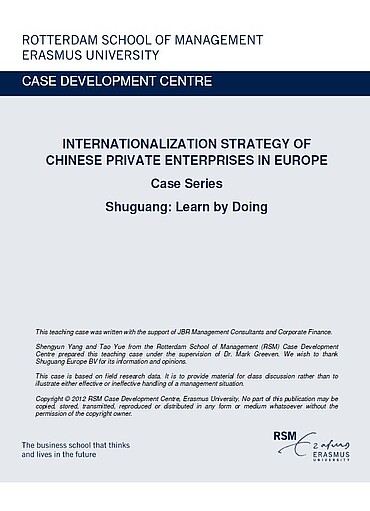Citation Note
Based on field research; 6 pages.
See also: Internationalization Strategy of Chinese Private Enterprises in Europe Case Series
Cycle Link: Procurement in Europe (http://www.ecch.com/educators/products/view?id=112486); and: Internationalization Strategy of Chinese Private Enterprises in Europe Case Series Chemre: Learn from Crisis (http://www.ecch.com/educators/products/view?id=112485)
Follow the 'handle' link to access the Case Study on RePub.
For EUR staff members: the Teaching Note is available on request, you can contact us at rsm.nl/cdc/contact/
For external users: follow the link to purchase the Case Study and the Teaching Note.
Objective
These cases serve four main objectives: 1. To understand the motives of private Chinese enterprises for internationalization based on a resource-based view (pull factors), transaction cost economics (push factors), and international business (firm-specific ownership advantages). 2. To understand the conditions for internationalization for private Chinese enterprises based on host and home country institutions, sectors, and firms. 3. To analyze an international business model based on strategic orientation, internal and external challenges and opportunities, value creation, and value capture. 4. To explore the potential challenges and solutions for a private enterprise’s internationalization process moving from a developing market to a developed market. If used in an executive program, these cases also help answer the following questions that concern many managers of multinational firms: 5. Are there any alternative entry modes of internationalization in addition to outbound foreign direct investment (OFDI)? 6. Which entry mode is most suitable for the enterprises in this series of cases, respectively?
description
This series of cases consists of three individual cases describing the internationalization strategy of Chinese private enterprises in Europe. China’s private enterprise sector is generally much more productive and profitable than its state-owned enterprise (SOE) sector. Having entered a new stage of outbound investment, an increased number of Chinese private firms have joined the “Going Global” cohort. These new investors represent many different industries from the SOE sector, usually characterized by innovation and dynamics. However, relative to the SOEs, these private sector investors were often confronted with a shortage of financial capital, capabilities, and human resources required for internationalization. These cases, therefore, display some of the characteristics of the latest Chinese investment phase in the Netherlands, such as their motivations for internationalization, global strategies, and challenges.
Abstract
This is part of a case series. Shuguang Europe was established in 2008 in the Netherlands. Initially set up to handle REACH registrations for its headquarters in China, it soon engaged in overseas sales, purchase of raw materials for its headquarters, and customer relationship management. With minimum understanding of Dutch laws and regulations and little help from professional service firms in the Netherlands, Shuguang Europe ran into trouble managing daily business until it switched accounting and logistics firms. After getting on the right track with daily operations, Shuguang Europe began to contemplate on a new business model.
usage
This series of cases are suitable for MBA, EMBA and other master’s students of management and business studies, as well as executives and managers of private enterprises and SMEs. The cases can be used in courses or training on global management, organizational management, outbound foreign direct investment (OFDI) or strategy in general.
